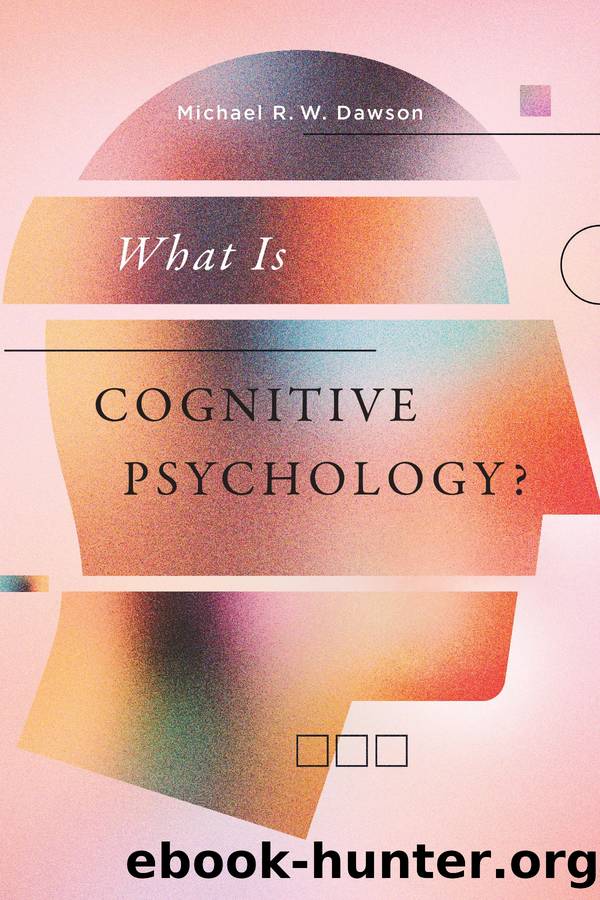What Is Cognitive Psychology? by Michael R. W. Dawson

Author:Michael R. W. Dawson [Dawson, Michael R. W.]
Language: eng
Format: epub
Tags: PSY008000 PSYCHOLOGY / Cognitive Psychology & Cognition
Publisher: Athabasca University Press
4.6 Structure, Process, and Control
The preceding sections described many possible architectural choices, which in turn produce a variety of cognitive theories. I now explore how cognitive psychologists can create radically different accounts of the same phenomena by making different architectural decisions.
Many examples in Chapter 2 involved the modal memory model (Shiffrin & Atkinson, 1969; Waugh & Norman, 1965). That model depicts memory as a sequence of different stores (iconic memory, primary memory, and secondary memory) with different architectural properties (symbols, processes, durations, and capacities). The architectural differences between stores in the modal memory model emphasize different assumptions about structure and process (Section 4.5).
However, we do not define information processing using only structure and process. Information processors must also incorporate control (Section 1.1). Control determines which process manipulates a data structure at any given time. Cognitive psychologists who emphasize control over structure and process produce very different theories from the ones produced by cognitive psychologists who emphasize structure and process over control.
The levels of processing theory of memory provides one example of a control-based memory theory (Cermak & Craik, 1979; Craik, 2002; Craik & Lockhart, 1972; Lockhart & Craik, 1990). That theory replaces a structural account of memory with a procedural account. Lockhart and Craik (1990, p. 88) sought to displace âthe idea (a) that memory could be understood in terms of elements (âitemsâ) held in structural entities called memory stores, (b) that the fate of an item so stored was determined by the properties of this store.â
Craik and Lockhart used depth of processing to displace structural accounts of memory. Depth of processing reflects the degree to which we analyze a stimulus. Deep processing involves a semantic analysis of an item. For example, participants might determine whether each word in a list belongs to the category flower. Shallower processing involves analyzing non-semantic properties. For instance, participants might determine whether each word in a list rhymes with train.
Participants who perform deeper processing of a list also perform better in a surprise memory test, supporting levels of processing as an alternative account of the memory phenomena introduced in Chapter 2. Many view Craik and Lockhartâs theory as attacking the distinctions between memory stores in the modal memory model. Craik and Lockhart believe that this view is overstated (Craik, 2002; Lockhart & Craik, 1990).
Importantly, depth of processing is under conscious control. We can deliberately decide to pay attention to stimulus meanings and therefore determine how well we remember items. Improving memory by performing deeper analysis offers another perspective on the mnemonic techniques introduced in Chapter 2.
Download
This site does not store any files on its server. We only index and link to content provided by other sites. Please contact the content providers to delete copyright contents if any and email us, we'll remove relevant links or contents immediately.
The Art of Thinking Clearly by Rolf Dobelli(10329)
Mindhunter: Inside the FBI's Elite Serial Crime Unit by John E. Douglas & Mark Olshaker(9266)
Change Your Questions, Change Your Life by Marilee Adams(7690)
Nudge - Improving Decisions about Health, Wealth, and Happiness by Thaler Sunstein(7662)
Mastermind: How to Think Like Sherlock Holmes by Maria Konnikova(7281)
The Power of Now: A Guide to Spiritual Enlightenment by Eckhart Tolle(5682)
Men In Love by Nancy Friday(5201)
Altered Sensations by David Pantalony(5071)
Factfulness: Ten Reasons We're Wrong About the World – and Why Things Are Better Than You Think by Hans Rosling(4715)
The Confidence Code by Katty Kay(4222)
Thinking in Bets by Annie Duke(4186)
Man and His Symbols by Carl Gustav Jung(4098)
The Worm at the Core by Sheldon Solomon(3457)
Why Buddhism is True by Robert Wright(3425)
Liar's Poker by Michael Lewis(3416)
Three Women by Lisa Taddeo(3393)
The Inner Life of Animals by Peter Wohlleben(3286)
Descartes' Error by Antonio Damasio(3250)
How Music Works by David Byrne(3235)
